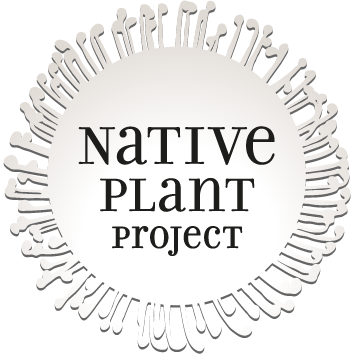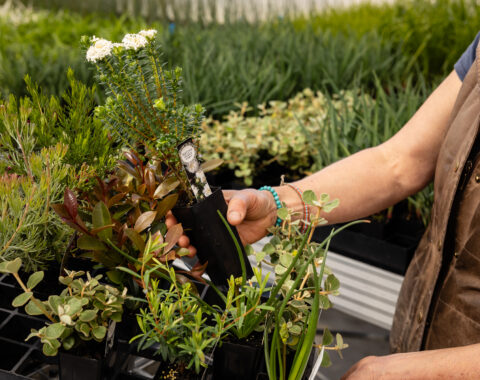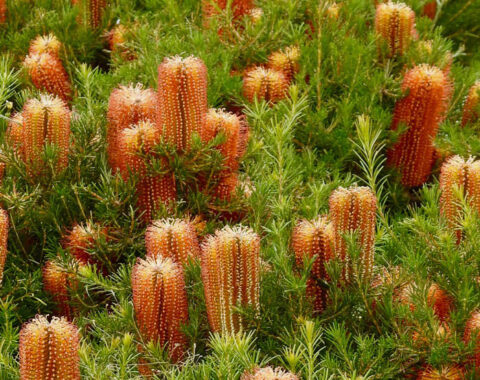- E-Nursery
- WINTER SALE
- Gardens
- The best of Australia’s private and public gardens to inspire your own Native Plant Project large or small.
- Learn
- Tips from native plant experts, growing guides, seasonal gardening diaries and more…
- Projects
- Meet designers, architects, landscapers and creatives engaged in their own native plant projects…
- About
- Contact
The buzzing sounds of bees, the joyous sight of butterflies dancing and the antics of birdlife are amongst the many delights of having a garden – large or small. But providing a pollen rich environment for bees and other pollinators brings untold benefits beyond your backyard…
Pollinating flowers, fruits and vegetables – bees are vital to the human food supply, we’d literally starve without them. In fact, one in three bites of food we eat is derived from plants pollinated by bees. Every garden can create a feeding ground for bees and other pollinators, so it’s worth putting some thought into making your garden inviting for them.
Top 6 Tips for bringing more bees, birds and butterflies to you garden…

Use local native plants where possible…
Research suggest native plants are four times more attractive to native bees than exotic flowers. Heirloom varieties of herbs and perennials can also provide good foraging.
Choose several colours of flowers…
Bees have good colour vision to help them find flowers and the nectar and pollen they offer. Flower colours that particularly attract bees are blue, purple, violet, white, and yellow…
Plant flowers in clumps…
Flowers clustered into clumps of one species will attract more pollinators than individual plants scattered through the habitat patch. Where space allows in your garden, make the clumps two metres or more in diametre
Include flowers of different shapes…
Different species of bees are different sizes, have different tongue lengths, and will feed on different shaped flowers. So, providing a range of flower shapes in your garden means more bees can benefit.
Look to plant varieties that flower at different times of the year…
Aim to have a diversity of plants flowering in all seasons. Most bee species are generalists, feeding on a range of plants through their life cycle. By having several plant species flowering at once, and a sequence of plants flowering through spring, summer, and autumn, you can support a range of bee species that fly at different times of the season
Plant where bees, butterflies and birds will visit…
Bees favour sunny spots over shade and butterflies in particular, need some shelter from strong winds. Also consider that unlike their European cousins, most Australian native bees are solitary, meaning the female will make a nest all by herself by burrowing into rotten wood, dirt or even sparse lawns. One of the best ways to help these hard-working single mums is to create some ‘bee hotels’ for the many lodger bee species. Lodger bees will happily build their nests in pre-existing holes that you can provide. You could cut lengths of bamboo or cardboard tubes and stick them onto a tree trunk or wall that is sheltered from the elements. You can also find some practical and quite beautiful bee-hotel making guides online that range from easy to extravagant, so get searching.
Our Top 5 favourite Australian native plants to add to your garden for bees, birds and butterflies…
Grevillea – Grevillea ‘Coconut Ice’

Nectar loving birds love grevillea and small birds can use the plant to nest. Great as a hedge or feature plant this hardy medium sized shrub once established is drought tolerant and can tolerate light frost. Enjoy the cream/pink flowers from Spring through to Winter. Add to a Native Plant Box for delivery here.
Guinea Flower – Hibbertia vestita ‘Golden Sunburst’

A very low maintenance ground cover that forms low mounds. It prefers well drained soil and full sun to part shade. Great around a pool, in a pot or as a colourful border plant. In Spring and Autumn expect masses of vibrant yellow flowers native bees will love. Add to a Native Plant Box for delivery here.
Silky Emu Bush – Eremophila nivea

Attracting bees, nectar eating birds and butterflies add to the appeal of this beautiful silvery foliaged shrub that will work well in containers, a flower bed and coastal gardens. It’s a plant best suited to dryer areas, preferring good drainage and a bright sunny spot. Try mounding soil to improve drainage, prune lightly after flowering and keep a good quality native fertilizer up to it to ensure flowering for most of the year. Add to a Native Plant Box for delivery here.
Bottlebrush – Callistemon viminalis ‘Pink Alma’

Mix up the classic red shades of Callistemon with the unusual, pretty mid-pink hues of ‘Pink Alma’. It’s a compact yet large shrub, forming attractive branches flowering profusely in spring and again (but less so) in autumn. Adaptable to sub-tropical to cool climates and most soil types, you’ll find nectar eating birds, native bees and butterflies will also love this variety too. Add to a Native Plant Box for delivery here.
Cushion Bush – Leucophyta brownii compact

This compact native shrub is grown more for its foliage than for its flowers. Drought tolerant and easy to grow its striking fine, silver, twiggy form will add structure to your garden and works well as a border. It is fast growing, suited to coastal gardens or exposed sites and poor soil – and provides a playground for butterflies. Add to a Native Plant Box for delivery here.














